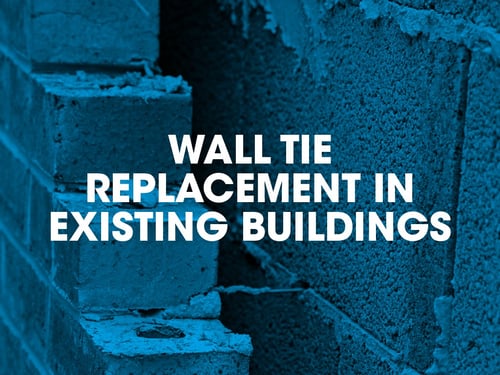How do you recognise a cavity wall?
A cavity wall may be identified by looking at the pattern or "bond" of the bricks. If all the bricks are laid with the long edges ('stretchers') facing you, the wall is a cavity wall. If alternate bricks are laid with the short edge ('header') facing you, the wall is probably a solid wall; 'headers' are used in this way to increase the strength and stability of the masonry.
Of course, if the wall is rendered or plastered and the bond cannot be seen then the easiest way to test its construction is to drill a small hole through the outer face to a depth of some 130mm. If no cavity is found in this way the wall is probably solid. This will be confirmed by checking the wall thickness at door openings or window reveals.
How it works
Structurally, the cavity wall is a load sharing system with ties laid out in a uniform spacing pattern: typically wall ties should have been installed in diamond formation with ties at 900mm horizontal centres, in courses set 450mm apart. At door and window openings the spacing is reduced to 300mm (max) vertical centres. The spacing of the wall ties may vary dependent upon cavity width and the type of wall ties used.
This spacing is most important where cavity walls are most vulnerable: in small areas of brickwork between openings and in large un-reinforced areas in exposed positions such as gables, where, in the absence of the lateral restraints nowadays required in housing, the walling derives no restraint from the junction with any upper floor or roof. The chief danger in these positions is from wind suction which, on the leeward side of a building, can exert considerable force which the brickwork, strong in compression but weak in tension, cannot withstand without effective ties at the correct spacing.
Historically wall ties in bronze, cast iron and slate are sometimes seen, the commonest material for wall tie manufacture is mild steel and the commonest manufactured forms were fishtail or vertical twist ties (either galvanised or bitumen coated) and the galvanised butterfly wire tie.
All mild-steel ties are susceptible to corrosion over time, as the Building Research Establishment has pointed out in its publications, particularly Digest 329 because the service life of the masonry is much longer than that of the mild steel it follows that at some point in its life the wall may need replacement of the ties.
The process of corrosion of mild steel causes expansion of the ties because the metallic oxide occupies a greater volume than the pure metal did. This expansion has the effect of forcing apart the bricks above and below the bed joints in which the ties are laid, producing a pattern of horizontal cracks coinciding with the tie positions approximately every six courses. In fair-faced brickwork this may frequently have been re-pointed in the past, resulting in thicker bed joints at regular intervals. There may be some associated diagonal cracking.
Because of their lightweight the corrosion of butterfly wire ties produces almost no detectable external symptoms. The tie can corrode right through without producing any evidence on the outside of the building of what is happening. But fishtail and vertical twist ties with their greater bulk of metal do produce sufficient volume expansion in corrosion to cause a visible splitting of the mortar bed in which they are fixed. Bulging to external cavity walls can also be an indication of failure and should be explored by intrusive investigation or the use of boroscope camera equipment.
Remedial treatment
Where there is wall tie corrosion or inadequate ties, or where wall ties have corroded to an extent serious enough to threaten the stability of the wall or building, a suitably qualified Structural Engineer must be appointed to determine the necessary remedial works.
The remedy for wall tie corrosion is straightforward: identify the positions of existing ties; install replacement ties in positions staggered from the originals at the appropriate tie density of 2.5 per sq. meter. Proprietary stainless steel remedial wall ties can be installed with little disturbance to the existing structure by inserting them into holes drilled at appropriate positions. These remedial ties are fixed to both leaves of the cavity wall by chemical or mechanical anchors. The work should be undertaken by a specialist contractor and specified and supervised by a Structural Engineer.
Installing replacement ties alone will restore structural stability, but will still leave the masonry prone to damage by expansive corrosion. Therefore the old ties must be treated in order to prevent any further damage from expansive corrosion, except in the case of butterfly wire ties. Remedial treatment to the existing ties is essential for a complete repair. Guidance on the remedial treatment required to the existing wall ties can be found in BRE Digest 329.
Ancillary work
The following ancillary work must also be considered by the Structural Engineer involved with the remedial wall tie works.
Lateral Restraint: In the course of remedial work it is usually possible to bring older buildings up to modern standards with the use of lateral restraints to secure floors and roofs to the masonry.
Pointing: Re-pointing of the masonry too will enhance its stability and should be considered as part of the work.
Further guidance can be found in Technical Manual Appendix D
References:
- BRE Digest 329 Installing wall ties in existing construction
- BRE Good building guide 62 Retro installation of bed joint reinforcement in masonry
- See also BRE publications
- Replacing Wall Ties Stock No 877
- Corrosion of Metal Components in Wall Stock no 138812

